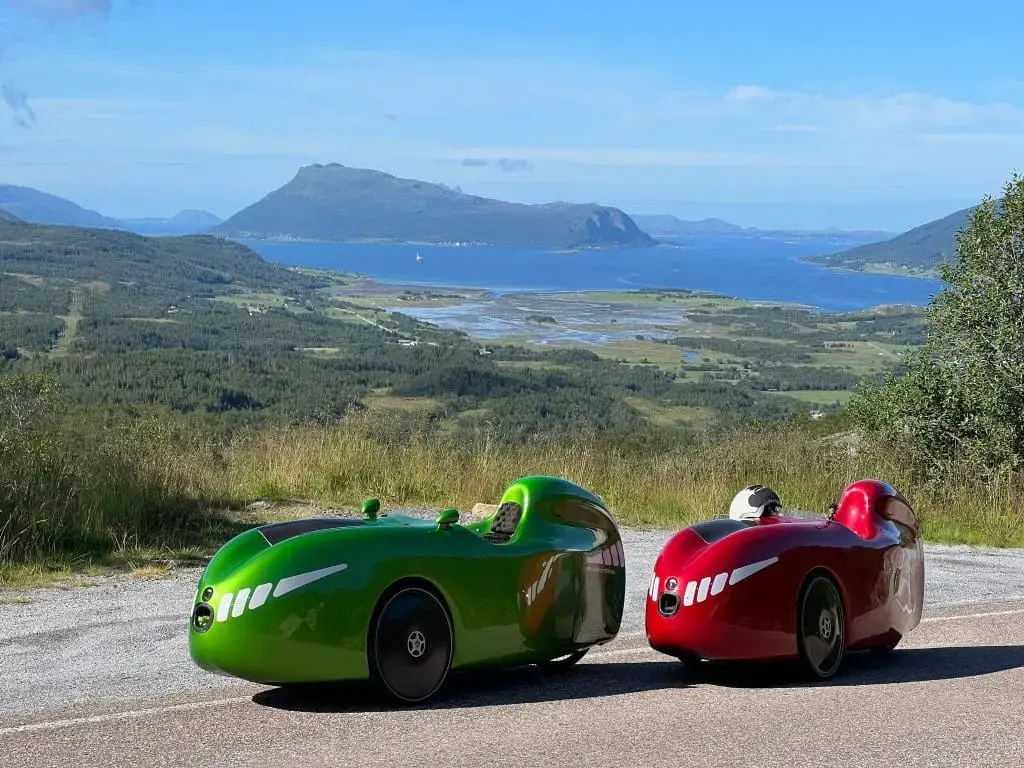Or, better yet, they could provide the same range in smaller, lighter vehicles with less resource use.
From the article:
“Moreover, the silicon-gel electrolyte system demonstrated ion conductivity comparable to conventional batteries while achieving a remarkable 40 percent increase in energy density. This represents a significant leap forward in battery technology, offering a practical solution ready for immediate application.”
So, same energy output, lower weight, similar range. Would be good if this soon becomes a drop in replacement option for older EVs that are nearing EOL on their batteries and require new ones anyway.
I’ve always said that about one of my big reasons for buying an EV several years ago. By the time I’m in need of a replacement battery, it will be better in virtually every way - safer, faster to charge, higher capacity, lighter, and (potentially) cheaper. The first replacement battery might not be much of an improvement, but my 3rd might be light-years ahead.
Looking at past actions of capitalism, it is more likely that same type of batteries will be sold for older cars and the new tech batteries will be only made for newer models, unless right to repair takes off, but who knows, still I do hope for a better and more sustainable future.
Since Prius are so popular and plentiful, and now quite old, there are companies supplying newer tech Lion packs with way more capacity, or lighter weight (or both) than the original Prius packs (many with NiMH packs).
I’m on the hunt for old Prius with dead packs as we speak.
No affiliation example pack: https://electronhybridsolution.com/product/toyota-prius-2010-2015-brand-new-hybrid-battery-rebuild-kit/
If other companies do it then it is possible, would love to get extra range on my Chevy volt
Those volt/bolt battery packs are a really neat design, but pretty densely packed, especially the cooling system.
I know a lot of conversions that use the volt/bolt packs, but to put different batteries in a volt would likely take a lot of custom fabrication and probably compromises in interior or storage space.
My only regret was not buying a more popular model. There are fantastic drop-in battery upgrades for the Prius and leaf, but less popular cars like mine will probably never get upgraded
What car did you end up getting?
Ford cmax, only gets about 20 miles on the stock battery. I don’t expect anyone to make a better one, and iirc Ford only sold like 1 model year with an upgraded (20%) battery.
I only hope a replacement is available for mine and that it’s not ungodly expensive.
I would be curious if this technology would be viable in other devices as well. I’d like 40% more energy density in my cordless drill and/or laptop please.
Would be good if this soon becomes a drop in replacement option for older EVs that are nearing EOL on their batteries and require new ones anyway.
Can’t wait for carmakers to fight tooth and nail to avoid making this a possibility for aging vehicles.
Lots of surveys show one of the primary barriers to EV adoption is range anxiety. I’ve seen people trying to “educate” potential customers out of this anxiety, but it’s pissing into the wind. You’re not going to convince most people to downgrade their current ICE experience while paying the same or usually even more. I think the inflection point is above real world range for ICE. For example my 2016 Honda Civic can get about 7-800km of range on a single tank, and stops are as quick as a few minutes. This provides a lot of flexibility about where and when one stops. The range needs to account for:
-
The 20-40 minute charge vs five minutes for gas.
-
The lack of chargers relative to gas stations.
-
The 30% drop in range in the cold.
Our annual Austria ski trip takes about 30% longer in our Model Y than the Civic. That’s hours extra on an already very long drive, and the Y costs a lot more. That’s a big downgrade in experience. An appalling experience with a family. We won’t be buying another EV until affordable range is above 1,000km (620 miles). I know many current, former, and non-EV owners who feel the same.
There is a market for commuter cars with poor range, but primarily in rich places where owning 2-3 cars is common. These rich places have already bought EVs as they are. Most of the world relies on just one car, if they own one at all. That one car needs to perform well in all conditions.
The concerns for range anxiety are well founded too. I had to rent a car the other day, and the only thing they had available was a Tesla model 3. Aside from the issues Teslas themselves have, the 90 miles I had to travel became an immediate concern because it was in a rural area and the town I went to literally had two chargers, and they were privately owned.
The 280 miles I was quoted as range quickly became 170, despite turning off the heat, not charging my phone, using cruise control at 3MPH below the speed limit, and changing all the settings I could conceivably find to turn down my power consumption. I wound up having to beg a private owner to let me use their charger because what would normally be a simple trip became a massive chore. My other option was waking up hours early to drive to a town 40 miles away where they had a super charger and leaving from there, also just barely making it back to the rental car return.
The time to charge the Tesla on a 220v charger btw was over 5 hours from 48%. Absolutely none of my experience matched that of the advertised and it’s completely turned me off electric cars until they can start fixing some of these issues.
It would be useful for electric bikes and things that you could feasibly own alongside a car and use for 90-95% of trips.
Or, here’s a crazy idea, for the one week each year where you actually need the range you rent a Honda Civic and leave your EV at home.
That’s not a good solution. Renting is a terrible experience too. This is what I would have to do:
-
Book a rental in advance or pay horrendous rates.
-
Take an overpriced taxi to the rental place on the day. Uber is banned in my country.
-
Wait in line, then stand through the strong arm sales tactics to get me to buy the overpriced insurance. I politely decline.
-
Take a hundred pictures of the exterior to prove I’m delivering it in the same conditions I picked it up because I’ve been scammed too many times.
-
Drive back to my house, then do all the usual packing.
-
Gingerly drive this strange car for 12 hours there and back and pray I don’t scratch it because that’s thousands of dollars in extortionate fees.
-
On return, unpack the car, then give it a clean (or more fees).
-
Drive it back to the rental agency and argue about the level of gas in the tank and the scratches I didn’t make and the level of general cleanliness inside and out.
-
Take another overprice taxi back home.
I’ve rented a lot of cars in my life and they’re all bloodsucking leeches. This is not only a much worse experience than simply owning a car which suits our needs, but it’s more expensive.
Your rental experience sounds worse than any I’ve ever had. I have to rent a few times a year.
Also generally I like the idea of renting and having the rental insurance on a long road trip so if something happens then my personal car isn’t totaled or put into a body shop somewhere far away. I’ve hit a deer hours away from home before on a road trip that was WAY worse. If it had been a rental I could have just walked away saying I have insurance so your problem, I need a new car. Where as it became an ordeal of the car being in the body shop 4 hrs away, still needing a rental to get home, since it was far away couldn’t check in on it and the repairs were bad, had to get a ride to get the car, ended up having to drop it off again somewhere local to fix the bad repair job, and get another rental.
I also had range anxiety for EVs on long trips and then I remembered that experience.
Could you recommend a good rental company? Maybe I’ve been picking the wrong ones.
Honestly I shop around to an extent and look at reviews for the area. I have to fly to an airport near family and then drive another couple hundred to get to some family. I’ll admit there’s a gambit in quality of the cars, but I don’t have a preferred. And seems like because a brand in x is good doesn’t mean their station in y won’t suck. Hence just hope in reviews being a good indicator.
-
“Save the planet? Sure, but only if it doesn’t slightly inconvenience my leisure activities or make me wait a bit longer.” This mindset perfectly encapsulates why we’re in such a mess: an astounding commitment to personal comfort at the expense of the planet’s future. It’s like saying, “I’ll help fight climate change, but only if it’s on my terms and doesn’t affect my ski trips.” Because, obviously, ensuring our convenience is far more critical than addressing a global crisis. It’s this precise “me first, planet later” attitude that’s steering us towards an ecological disaster, yet here we are…
If you already have a car with a combustion engine and it runs fine, you shouldn’t just buy an EV because “it’s better for the environment”. If you’re doing that, it’s actually worse for the environment.
I’m fine with only being able to buy EVs in 10 or 20 years, once batteries are better and the vehicles are actually affordable. Until then, we need better and more hybrids.
thanksCEO of Toyota.
20-30 years lol it’s cute you think society will still exist then.
Sorry, but if your argument is “here’s a shit product. It’s also more expensive, but you should still buy it because it’s marginally better for the planet,” it’s going to fail to achieve mass adoption. I care very much about environmental sustainability, but I’ve been around the sun enough times to know that the way to achieve that is with better and cheaper products. We should use technology to reduce environmental impact and improve our lives. It’s not one or the other.
So… if the technology isn’t improving your life you continue to use the one that’s making everyone else’s life worse? Even if you have the means to switch to the marginally less damaging one, that’s marginally more annoying? Sounds like serious entitlement to me. The idea that no downgrade is acceptable is niave AF.
So… if the technology isn’t improving your life you continue to use the one that’s making everyone else’s life worse?
It depends on the cost/benefit analysis. It was part of my decision to buy a Tesla but I am deeply disappointed with the experience. It’s so bad that I want to sell it and buy another ICE. Most people aren’t willing to pay more for a significant downgrade. That’s just reality.
i guess this a pertinent example of why we’ve got basically zero chance of stopping climate collapse. I’ve no doubt your position is very much the norm. We’re all required to make massive sacrifice to solve this, but very few are willing to make even small concessions)like less convenient driving practices).
Oh well it’s gunna be exciting to watch the ship sink at the very least.
At least you acknowledge your shitty position. it’s more than most seem to do.
I’m much more optimistic. I think battery technology will progress quickly, and as it improves, more and more people will buy EVs. I think the path forward is not to try to convince people to live worse lives. That’s a losing proposition. We should instead make our lives better and cleaner through technology.
To be fair… Electric cars have many of the same planet-damaging properties of gasoline powered ones. They’re a step in the right direction and necessary for the cases where we can’t replace cars, but they’re still an incredibly energy-intensive means of transportation that release enormous amounts of particulate pollution from the tyres and take up huge amounts of land. When combined with other changes we’ve made to our built environment to accommodate cars, they also leave many people in a catch-22 where they’re forced to pay hundreds of dollars every month for car ownership because we’ve demolished and rebuilt our cities in a way that makes not owning a car impractical.
-
Why would we do that? I want to be able to sit in a car for 10 hours, pee in a bottle, and eat sandwiches I prepared ahead of time. This is an excellent way to spend most of a waking day. Who wants to do something as silly as getting out to stretch?
Article states the use of an electron beam to enable this. So not currently scalable, but still a seemingly significant result.
Oh I know, just put it in an oven. Trust me, I saw one video on impossible blue LEDs, I know what I’m talking about.
A microwave oven? According to some YouTube videos, Apple had this tech in their phones years ago.
They still do! Fastest wireless charge in the West.
It charges it so much, you’ll never need to charge it again.
I saw that video by Veritasium I think. That just was tenacious.
Can you expand on this? There used to be multiple electron beams in every house in America.
Ok, maybe it’s possible that they aren’t using a very focused electron beam, but usually when scientists think about using an electron beam they mean something inside of a machine like an SEM or e-beam lithograph. These only operate on small areas.
If an unfocused beam (and therefore lower energy density) can be used, then this could likely be scaled more easily. Even if a focused beam is needed, scaling may still be possible, but will likely require additional developments to create that process.
All of the beams in my house have electrons
Oooohhh, battery revolution claim #3515351657829, one of these days one of em MUST be true!
It’s not Toyota making the claim this time, it may not be bullshit for once.
You mean Tesla?
At least Tesla actually make batteries, all Toyota ever do is just claim that the future is some other technology that they are developing. Usually it’s one that makes absolutely no logical sense.
Normally they go on about hydrogen power cells, which have never worked properly.
Nope, Toyota.
Since 2008 they’ve been trotting out a story annually that their amazing solid state batteries are only 2-3 years away.
They’ll revolutionise EVs, so there’s no point buying one now. It’ll be a worthless dead end.
Buy a proven Toyota hybrid instead to tide you over.
1k mile or kilometer range? Which is it? I’m inclined to believe it’s kilometers. Time to read the article, I suppose. It’s enticing either way.
A bit misleading but yes, 1000km is what they are talking about. Also the article doesn’t address scalability.
Well, there’s a lot the article doesn’t address. I can say this with complete confidence, even as someone who hasn’t read the article
Edit: don’t freak out, I eventually did read the whole article. Every word. And I was right.
You READ it? What kind of madlad are you?!?!
Now read the research paper and translated that for us
They demonstrated 40% increase in energy density.
The stuff about the range appears to be simply applying that percentage to common EV ranges, which is nonsense. It’s probably more likely that an increase in energy density would be used to decrease battery size, leading to cheaper and lighter EVs
The title says “1000 miles”, the the subtitle right below says “moving closer to 1000 kilometers” which is only 621 miles and pretty close to what we already could do with a ridiculously big battery in a Lucid Air or Tesla (if they didn’t bother with the plaid speed bullshit and just build for single motor range).
Stupid editorial work for maximum click bait.
Sounds nice, wake me up when it’s available
You can probably sleep for a heckin long time.
So how long can we play Steam Deck?
The only measurement that matters
I wish people would stop obsessing so much over range. Once we have decent charging infrastructure in place and people overcome all the FUD, this will simply cease to be relevant.
Some people don’t want to feel like they have to stop every hour for 15-20 minutes. If I’m going on a long road trip I’m fine driving 300-400 miles without stopping. I’m probably a minority but I’m sure I’m not the only one.
You’re certainly not the only one but you’re also being grossly irresponsible. Sufficient breaks are essential for staying attentive. Not stopping for five or six hours is just asking for disaster. Just think about what you’re going to feel like if you killed someone because you fell asleep at the wheel.
Edit: and as per usual, lots of downvotes but no counterargument
Gonna upvote you, anyone who isnt taking regular breaks on long trips is asking for trouble. This is true of anything we do. No one here is going to argue we should work for 5-8 hours without a break.
They only make driving lessons 45 minutes because any longer and you start to lose concentration.
Truck drivers have to take breaks every 4.5 hours for 45 minutes.
When studying they recommend a 15 minute break every 45 minutes
When learning in school lessons are 45 minutes to an hour due to concentration lapsing and you get a break in the middle of the day.
If you are being downvoted its only by people who dont think about what you are saying or they think they are superhuman and the normal limitations of human beings dont apply to them.
Truck drivers have to take breaks every 4.5 hours for 45 minutes.
Is this a specific state requirement? I ask because that’s not what the FMCSA says. It’s 30 minute break every 8 hours (USA) and it can be any activity including including work (except driving) that would satisfy the requirement. Source, am a truck driver and https://www.fmcsa.dot.gov/regulations/hours-service/summary-hours-service-regulations see 30-minute driving break section.
I’m most familiar (although casually) either UK/EU rules, and this page has an excellent breakdown of what’s considered the bare minimum this side of the pond for safety.
https://www.gov.uk/guidance/drivers-hours-goods-vehicles/1-eu-and-aetr-rules-on-drivers-hours
Personally I prefer to have a 20-30 min break every 2 hours which leaves me feeling sufficiently refreshed, and conveniently works perfectly for changing a 64kWh EV enough to do the next leg at the same ratio. I honestly believe switching to an EV has forced me to become a safer driver with regard to taking breaks.
I think most of the regulations for truckers here in the US were made in mind with how long the distance is between everything.
As far as driving my EV goes, ideally I would like to get 3-4 driving hours in before recharges, but only when the drive is longer than 6 hours total. I’d rather just get there sooner. I currently drive a Bolt EUV and it’s an hour charging for every 2-3 driving. Longer road trips take some planning especially when driving across middle America where the charging network isn’t that great yet. Meals are easy, but in between meals planning an hour long stop can be challenging.
Sorry im in the UK and was going off the uk and eu laws.
30 minutes every 8 hours must be tough. Do you do back to back periods of 8 hours?
I was just thinking that if its 8 hours then a break but your shift is done, then the break is just the end of your shift.
All of our driving has to be completed in 14 hours (11 hours driving total). When I drove over the road (not home every night) I usually tried to aim for a leg stretch every 4 hours. I’d usually walk around the rig and check things out for leg stretchers. For the 30 min break I would find a rest area or a truck stop and have a proper meal and I usually took longer than 30 for that break unless the place was boring. When i would take breaks were usually determined by location along the route.
If there are reliable and fast chargers every 50 miles you’ll have several choices in that 300-400 mile range and we already have plenty of cars capable of that. The goal is not to have everyone stop at every charger. But to allow more people to drive how they are most comfortable and maybe even enable more cars to road trip.
You’re not the only one. Most people try to make as much distance as possible between stops.
We need more data for everyone to see.
We need to see what the average vehicle owner does with their vehicles.
Because the people who use their cars they most need the best experience, but they used the vehicle differently than the majority of people.
Evs need to be released on different models for different styles.
If you only travel with people that need constant breaks, then there no reason needing a 15 to 20 minute break frequently can’t be made to work with a lower range vehicle if you only need to do long trips a few times a year or less. The savings of having that vehicle the rest of the time should be made to more than offset any special needs that aren’t needed often.
There’s other options to explore as well. Like it’s easy to find example of vehicles with multiple gas tanks. If you need an extended battery there should be a trailer like attachment that extends the range of your vehicle. Make towing something get you better range because the thing you added towing is extra “fuel”
I’m sure there are technical problems that will need to be addressed or solved and it might require car companies to change designs about to make it seams but it’s very doable
Yea…no. Most of the USA is rural areas, range is a huge deal.
Exactly. Ideally in cities and surrounding suburbs we would want public transportation and no cars. Cars should really be reserved for the more rural places anyway.
Then you need to figure out the range issue.
Let’s take the absolute worst case I could find for North America: in Quebec between Matagami and Radisson there is a 620km (390mi) distance between gas stations. This exceeds the range of many ICE cars, but let’s continue. It gets real cold up there, and there’s a few days out of the year where it’s well below 0F. To account for the cold, let’s increase that distance by 40% to get to about 550mi.
There is one EV on the market right now with a 516mi range, the Lucid Air. So it can’t quite make it under the absolute worst case conditions that, even up there, will only happen for portions of the year. Many ICE cars would also fail to make it.
This problem is completely overblown. The 1,994 combined population of those two Canadian towns will have to wait. Literally everyone else in North America will be fine if we just get our charging infrastructure better.
Oh, and ICE cars lose gas mileage in cold weather as well. 15% lower at only 20F. So ICE cars that could barely make that trip under warmer conditions probably couldn’t under the extreme cold of this exceptional situation.
Gas cans do exist. You can’t carry a substation with you.
Great, that will help you drive right past the point.
You just need a charging station every hundred kilometres or so, that’s perfectly doable even in sparsely populated areas. In fact, this kind of infrastructure is far easier to roll out than gas stations.
I’d rather not refuel in -20F weather on a single trip. Add in a trailer and a road trip becomes a charging trip with intermittent driving.
Yep. People in the city, EVs are fine. For those of us who haul or have to drive farther than 20 miles it becomes an issue. It’s not there just yet for us. I’m still holding out for hydrogen ICE motors.
Where do you get the idea from that an EV only has 20 miles of range? Have you ever even seen an EV let some driven one?
Uhh where did I say that they only had 20 mile range? I said for those of us who have a drive that’s farther than 20miles one way. Most of people who travel usually do 45-60 miles just going to and from work daily. Then you add in errands, the range needs to be better.
I agree that increased range would be better - I’ve had cars (diesel) that could get nearly 600 miles on one tank and that allows you to do a lot more wandering though the countryside that is just not possible in an ev in the rural US. But it’s way more than 20 miles. Did you mean 200 miles?
I’m currently on a road trip in my 2021 EV and it can definitely be made to work, but it is definitely limiting on any spontaneous side excursions you find, which can be a pretty big bummer.
Double the range would definitely be appreciated for my use cases.
Good thing we make decisions based on something that happens for a few days out of the entire year.
This isn’t like the consequences of adding a water filter means you now have to change a water filter every year, this is something that would turn a vacation into something unenjoyable. Meaning it’s a decision that would make you give up that type of vacation if that’s your only car. It’s a sacrifice not an inconvenience.
See the math here: https://midwest.social/comment/6976296
You have to look for incredibly specific situations in North America for current EVs to not be able to make a stretch of road. So much so that many ICE cars would fail at it. We do need better charging infrastructure. Better batteries are desirable for many other reasons, but not required.
Trailers have a habit of cutting the range by 66%. Someone I know has an EV and tows their bikes to a nearby city. They have to charge mid trip in both directions. That’s unacceptable to me and a lot of others. I’m fine with a vehicle with 300 miles of range. But 100 miles of range to tow a boat? I wouldn’t make it back without a recharge. Probably two charges because charging stations wouldn’t be anywhere near the lake in rural areas. So in that scenario I would have to give up boating for an electric vehicle because I’m not about to do that.
Yeah, we should make all our infrastructure decisions based on the rarest edge cases.
You do what you want. But I’ll make my infrastructure decisions based on my edge cases. Others will as well. Sometimes those edge cases are important to people.
Not to be a dick but do you realize how rural rural America is?
They have electricity there, don’t they?
To be a dick, have you actually measured distances between gas stations in rural America and thought about how this would work if we replaced them with chargers?
I’m not saying we shouldn’t but range is important especially to rural drivers… and super important to wide scale adoption
Range is basically solved for the vast majority of the population at this point. There are chargers every few hundred kilos along all main interstates. Apart from those living out in extremely rural locations or living situations like apartments where you can’t charge at home, you’d be fine. For those that fall into that category…well, don’t buy an EV, lol.
Wait you think digging a hole and putting in a few tanks to store gas is harder than having substations near by to power super charge stations?
The answer is no, no it is not easier or cheaper.
So what do they power those gas pumps with? Electricity, by any chance?
You do understand a 400amp service is usually what those stations run off of right? You’re not getting multiple super chargers from 400amps. You need substations for them.
Once we have decent charging infrastructure in place
I think part of the range anxiety thing is that buyers think of their worst trip, target than the average trip.
On average, Canadians commute 8.7km to work. Those who commute for more than 60 minutes are averaging 40km. For these trips, drivers don’t need charging infrastructure beyond what they have at home. (And yes, public transit would be an even better option)
There are always outliers, and every time this comes up, people talk about how far they drive on road trips and vacations. Those are not normal use, and they should probably be handled by renting an ICE car.
Or just getting on a plane to go somewhere far, rather than spending three days of your already limited vacation driving past corn.
I drive 82 miles a day on average according to my tracking, but that frequently involves days of 400+ miles. And since I drive in hill country and require air conditioning most of the years I know the range estimates are wildly optimistic versus real-world performance.
And charging a car isn’t like filling up with gas. It’s not a 3-minute stop. If a car can get me as far as I’m willing to drive in a day, then an overnight charge seems like an option.
But even then, since I’m a renter and always will be because of the shit going on with housing I can’t get a fast charger.
All of this is to say that it’s not 1 issue. It’s all of them. Range, charging speeds, and availability of chargers ALL have to be addressed and essentially 100% reliable before I can risk owning an all-electric vehicle.
Not a 3 minute stop. A whole 15 minutes. Assuming you have a charging station nearby anyway.
I own a 2022 Model Y and I’ve never had a 15m charging stop. It’s always longer. 15m is theoretical. In the real world everything from temperature to the type of charger to how many people are charging at the station to the age of the battery impact speed. You’re looking at 25-40 mins on average to 80%. Double that to charge to 100%. I’m not sure why people feel the need to gaslight non-EV owners. The technology is what it is.
The Ioniq 5 is rated at 18 minutes 10 to 80%. If you really care about charging time, you don’t need to charge all the way to 80. It starts to slow down after 70. And that’s current technology. It’s only getting faster.
As I explained, the rated time is in perfect conditions. I have never experienced perfect conditions and I don’t know anyone who has. I have a colleague who has a 2023 Ioniq 5 who claims to average 30 mins for 10-80. This will only get longer as the battery ages.
I always find it amusing how people go through such mental contortions to justify not buying an EV. If you don’t want an EV, just don’t buy one. Nobody cares.
That’s the thing. I DO want one.
But there’s still significant drawbacks, and some of them are being completely ignored. The renter issue is HUGE.
FWIW I’ve had an EV for four years now and I rent an apartment with no charger too. There have been times when finding a charger has been inconvenient. But I’ve never looked back. None of those problems are insurmountable and most of the time it’s a minor inconvenience at worst.
What FUD I’ve seen the word a couple times today.
Fear, Uncertainty, Doubt
I live in an apartment complex with no chargers. It doesn’t matter how much the infrastructure is, if I have to sit once a week to charge my car at a Denny’s, then I’m not interested.
Now, if you say I only need to do that once a month… Hmmm… I’m listening…
That’s not how this stuff works. I never sit in my car waiting for it to charge. Sometimes I’ll charge while shopping. Plug in the car, do your weekly grocery shopping come back, drive off. When you use a level 2 (shower) charger, you leave the car and come back after a couple of hours. It obviously depends on the available infrastructure in the places you normally go to. Takes a bit of planning and a bit of forethought. But it’s really not rocket science.
Ya, probably better in your neck of the words. Probably better once there is better infrastructure for me
Energy density is the key component. It’d mean less weight for the same range so even if you make a 200 mile range vehicle instead of a 1000 mile range vehicle, the much smaller battery and lighter weight of the vehicle would make a huge difference, plus it’d be cheaper to make in general.
I’m somewhere in the middle. I’ve thought about getting an EV my case is a 2012 Camry… And it’s still doing fine, but it is getting up there in the years.
I don’t drive much at all three days since I work from home.
When I do drive it’s roughly 150 miles to my parents or my grand parents. It looks like without installing something at their houses I could charge up 120 miles in a 24 hour period with the car entirely on the charger (but sometimes I want to go drive around and see friends or things and that’s time the car is not charging so … 120 miles might be an over estimate in some cases). That’s a bit uncomfortable especially when the cold weather makes the range drop so the “320” miles total becomes closer to “270”. Then there’s the whole thing where batteries lose capacity over time…
That means I’m going to potentially need to plan for stopping at a charger. There really aren’t that many chargers available between, e.g. where my parents live in Marietta Ohio, and where I live in Akron Ohio. When looking at a map (provided by Ford for the Mustang Mach-e I was looking at) there were maybe a dozen charging locations with pretty much 1-3 chargers each … That’s compared to a dozen busy gas stations I’ve encountered with ~8 pumps each.
I’d probably be fine but … I think I’d be better off waiting a couple of years and seeing if the 600 mile EV range becomes a reality. At that point all of my regular trips are accounted for and I’m okay looking for charging on the odd times I go on a large trip.
Alternatively, maybe there will be more chargers by that point (or charging will be faster) and I’ll feel more comfortable that I’ll be able to find a charger when I need it.
I don’t want my long 2 1/2 hour trip to turn into a 3+ hour trip on the way back … or turn into a particularly dangerous or sketchy situation because the charger I need is being used by someone else/down for maintenance/broken and it’s very cold outside.
I live in California, so the infrastructure is likely more built up here, but I regularly make trips from the SF Bay Area all the way to San Diego or Las Vegas just fine. On a shorter 2.5 hour trip, I could see it being annoying, but a couple charge stops on an 8 hour trip offer a nice time to take a break to grab a quick bite and carry on. Just my two cents.
I’ve thought about that too, but the stretch of road there is basically an interstate through the country side the majority of the route. There’s very little in terms of interesting cuisine or places to really walk around.
Could not agree more.
If anyone cares, I think this is the research paper. https://onlinelibrary.wiley.com/doi/10.1002/advs.202305298
Thanks for the source. I wish I understood it better
This research was focused on the lithium battery anode. Ideally we could just put a chunk of lithium in there but the stripping and deposition chemistry doesn’t work well long term. Modern batteries use graphite instead. But of course you waste a significant amount of cell volume and weight with all of that carbon, and the potential is lower than Li metal. Alloying Li with silicon gets you properties more similar to Li.
So this paper talks about their efforts to make LiSi more viable as an anode. They gave it a coating to protect it from electrolyte side reactions and created a new gel electrolyte formation reaction. The capacity they report isn’t remarkably higher than what’s out there now since the cathode is the heaviest part of the cell.
As to the results I do have to say 60% capacity retention after 200 cycles is not nearly good enough for real world use. And I have no clue where they got the “1000 mile range” headline from.
Thanks.
I figure the 100km range is firstly km, not miles, but then an ignorant editor “trying to be helpful” by multiplying sone number from the article by something they consider a standard EV
That would go a long way towards solving the range anxiety barrier. 1000km is close to the maximum that same people can do in a single day. Yes, you could push further in a day in a pinch, but not comfortably unless you’re rotating drivers. It’s pretty close to the limits enforced on long haul truck drivers in Canada or the US (depends on speed limits and traffic density and a few other things).
How many gas powered cars can go 1000km without refueling?
Refueling takes 5 mins max, recharging right now takes 15-20 mins if there is a super charge station.
When you work out how to do this in practice, it doesn’t actually matter. You really should be stopping for ~20 minutes every few hours, anyway. Put in better charging infrastructure and there isn’t much point to vehicles over 400 miles of range. Even 250mi is probably enough. Use further advancements to reduce weight, not push range further.
And before someone shows up who thinks nobody else has heard that batteries have shorter range in cold weather, yes, I’m accounting for that.
After driving non-stop for 200+ miles I’m more than happy to take a break for 15-30 minutes to stretch my legs, hit the bathroom, grab some food, etc. My wife and I have done precisely this on multiple road trips that we’ve taken in our EV.
Diesels.
It’s not 1000km. You lose 30-40% range in the cold. And charging cadence is typically 10-80%, not 0-100%, so you lose another 30% on road trips. Now your 1000km EV does 420-490km between chargers. That’s around three hours on the Autobahn at a rather leisurely 150kph, with a 25-40 min stop. I agree with the user above. Affordable 1000km range is minimum before I’ll be buying another EV.
Sodium is the future of batteries right now.
Projections from BNEF suggest that sodium-ion batteries could reach pack densities of nearly 150 watt-hours per kilogram by 2025. And some battery giants and automakers in China think the technology is already good enough for prime time. 1
+1 for them not exploding too.
Why is it superior to Li-Ion? Li-Ion has an energy density of up to 180.
because it has the potential to be sustainable, cheaper, and less explosive. It’s not technically superior as far as energy density goes, but right now batteries are prohibitive in many applications, moreso due to cost than weight.
and Glass pack batteries
I won’t be buying a new car. ICE or EV. Specifically because my old car doesn’t have a lot of the things that allow the car manufacturer to spy on me, and I won’t upgrade to any of the nonsense. Right now I can fix pretty much everything in that car for less than the price of a new vehicle.
I’ve managed to somehow make friends with the owner of a local junkyard. Not quite sure how I did that it wasn’t intentional but it’s quite useful because I can get parts for my car that the manufacturer would want hundreds of pounds for otherwise.
In the future I bet they pull some apple style rubbish and start software locking components to individual vehicles so you can’t just pull them off a donor car to fix yours
Better hope donor parts don’t start getting used to by pass security features or this will happen in an instant
Seems unlikely. For one because donor parts like computers would have to be programmed (either by the manufacturer, or a mechanic with access to a scan tool that could do so), and so if you need a new ECU you’re limited to those options or a third party service that will clone that computer. And two, most of the things I’d need to replace on that car that aren’t computer related are easy to get second hand from a pick n pull, junk yard, or aftermarket and don’t really have the kinds of electronics used to send and receive info to a car manufacturers servers. I’m not worried that my MAP sensor is gonna spy on me to BMW. I would worry if it were an ECU or a TCM or the like. The other thing is it would require upgrading the 3G chip in a lot of cars on the road to 4G or similar and or plugging a 4G device into the car somewhere like the OBD port which would be quite obvious in my car.
Removed by mod
Removed by mod
The problem is we can’t keep the same resources waste up. Lower range and smaller cars is what is needed. The perfect car of the future would be a one-seater that is as small and light as a electric velomobile (~70kg). Build a few millions of them and replace all cars in a city with those. Ideally self driving and as a robo-taxi, but even without the self driving this would be good. Of course cars isn’t really that high on the list for climate change.
But as a civilization we are simply not an intelligent species.
A single person vehicle will never be the solution because families exist. No parent would want their kids in a separate vehicle.
I wish my kids would have separate vehicle sometimes. I’m sick of playing eye spy with people that can’t spell.
yeah but think of what would be lost when the saying, “Don’t make me turn this car around!” is never uttered again. The loss of decades of tradition… ;)
Yeah I always wish my car had one of those divider windows like limos have so I can close the kids in the back when they argue. It’s not really offered though haha
Yeah it’s not a solution to everything. I imagine the standard “super light” robo taxi as a two seater with the seats facing each other. Without a driver seat you can redesign individual transport to be narrower which improves aerodynamics.
But yeah for families or cargo transport you still need larger vehicles. Or take two. And I also imagine this to be more of a “gap filler” besides public transport or bicycles. It would really require a pretty big redesign of how we live and work to reduce our energy and resource usage to zero.
I’d love gel and lithium-ion batteries in an ebike or a velomobile. It would result in a 40% increase in range with no extra weight, making them more of a viable alternative for somewhat longer commutes (think 10-15 miles). Sure we should be serving those by high speed public transit, but this would be a faster stopgap/alternative.
Oh and it would be useful for electric trucks too, even short-range ones could be made lighter with less batteries.
Actually surprised how little cars actually contribute to climate change I thought it was a major factor but they’re not really. If everyone in the world just switched to using LED light bulbs rather than incandescent it would be equivalent to removing half of the world’s cars from the road. And honestly seems easier to upgrade everyone’s light bulbs to LED than to replace every car.
Directly via exhaust? It’s a significant number, but maybe not the biggest one. But add manufacturing, oil (or battery materials) extraction and refining, road infra construction and maintenance, emissions connected to suburbanization, microplastic pollution from tires, health and safety impact, and you’ll get a much grimmer picture. LEDs won’t cut it, and cars do not scale to 8B people.
I too watched veritasium today
Yeah, the single biggest thing we could do is ban industrial meat production and regulate food production to be more local. But the overall scale of change needed is staggering. We’re not going to do much really.
Lmfao tell me you’re an over privileged fuck in some hyper urban city without using those exact words
My life, and lives of hundreds of millions of people in the global south would go TO SHIT if this euro-centric shit takes™ ever get any light of day
how do we magically get goods to and from?
grocery store trips?
what about other items from the store such as TVs?
what about families?
have you seen what is required daily or weekly for a baby?
what about a Micro Center trip?
https://www.velomobileworld.com/

not intelligent to be able move people and objects around?
travel over 3,000 miles every few months for work out of state and could not see myself in that taking naps at a rest stop comfortably
with such out of touch comments the petrol conundrum may never be solved
Consider something like 50% bigger than a podbike.
3000 miles is not something we as a society should accommodate to travel by car. The whole problem is that everyone thinks we can keep doing the same lifestyle just with zero carbon. We simply can’t. We need to change how we live and work.
Huh this video just dropped which is one possible solution to design a different work / live environment. If you imagine a village like that but large enough to have a school and some more amenities: Building a village designed for people (not cars) near Phoenix
But you’d still want public transport, bikes and delivery vans. But in Europe you also get a lot of cargo quadricycles to deliver goods.
Here is an alternative Piped link(s):
Building a village designed for people (not cars) near Phoenix
Piped is a privacy-respecting open-source alternative frontend to YouTube.
I’m open-source; check me out at GitHub.
deleted by creator


















